Removing
Mark the position of the rear wheels relative to the hub so that the balanced wheels take their original position during installation. For marking, it is enough to make a stroke with chalk or paint on the disc and hub.
Raise the rear of the car, remove the rear wheels.
Attention! If the brake pads are to be reused, they must be marked before removal. Swapping pads from the outside to the inside and vice versa, as well as from the right to the left wheel, is unacceptable. Such a shift can lead to uneven braking. It is highly recommended to use only genuine Opel brake pads. Be sure to replace all front disc brake pads at the same time, even if only one of them has reached the wear limit.
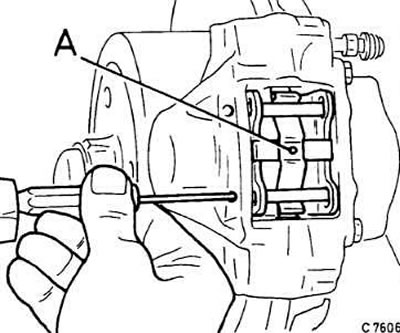
Knock out the retaining pins with a drift from the outside to the inside. Make sure that the pad springs do not pop out.
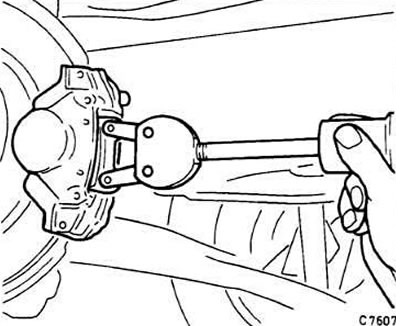
Remove springs A (see fig.C7606).
Remove the brake pads and linings with pliers, a screwdriver or an impact puller. If the pads are stuck, you will need a special puller (e.g. Hazet).
Installation
Attention! When the brake pads are removed, do not press the brake pedal, otherwise the piston will fly out of the housing.
Clean the guide surfaces and pad mounting locations in the housing with a soft metal bristle brush or clean with a cloth soaked in alcohol. Do not use any solvents containing mineral oils or sharp instruments.
Before installing the pads, check by hand that there are no grooves on the brake disc. If necessary, the discs can be machined if they are of sufficient thickness.
Measure the thickness of the brake discs.
Check the boot for breaks. Replace a damaged boot immediately, as penetrating dirt will quickly lead to loss of tightness of the caliper.
Press the piston with a forcing tool. If a tool is not available, this can be done with a hardwood rod, being careful not to skew and not to damage the surface of the piston and anther.
Attention! When the piston is depressed, the brake fluid is squeezed out of the brake cylinders into the reservoir. Monitor the fluid level in the tank, pump out excess if necessary.
When draining, use a plastic bottle that is only used for brake fluid. Do not use drink bottles!
Attention! Brake fluid is poisonous! In no case do not suck it through the hose with your mouth!
After replacing the pads, the brake fluid level in the reservoir should not exceed the mark "MAX", because the liquid expands when heated. Leaking brake fluid gets on the master cylinder, destroys the paintwork and causes corrosion.
Attention! If the pads are very worn, check the ease of movement of the piston, for which insert a wooden block into the caliper and ask an assistant to slowly press the brake pedal. The piston should move easily. For comparison, install a different brake caliper. Make sure that the piston does not jump out of the caliper. If movement is difficult, repair the piston.
Check piston position "20°". In workshops, a special template is used for this.
Attach the brake piston template to the lower guide surface. The piston position is considered correct if the attached template (position "20°") coincides with the tides of the piston.
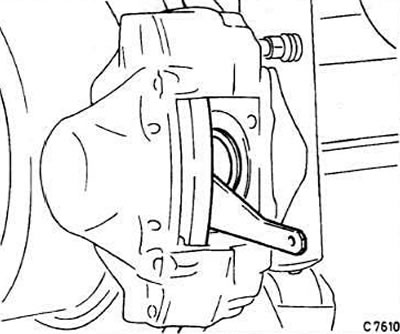
If necessary, carefully turn the piston with a special collet to rotate the pistons.
Check the ease of landing pads in the guides.
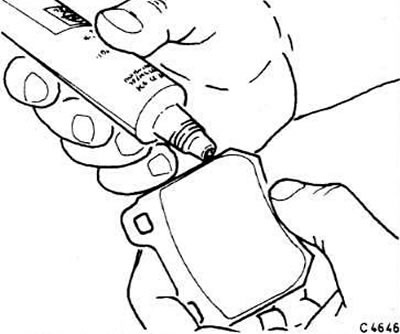
To prevent brake squeal, lubricate the side support of the rear brake pad plate with a thin layer of special paste, such as Opel 1942585, Plastilube, Liqui Moly LM-36 or LM-508-ASC. In this case, the paste should be applied only to the back plate; The paste must never come into contact with the brake lining. If this does happen, immediately wipe the pad with a clean cloth and rinse with alcohol.
Insert brake pads B and linings A into the caliper (see fig.C4647).
Insert the expansion spring and drive in the retaining pins from the inside out. At the same time, press the spring with a screwdriver, as shown in Figure C7606 (see above).
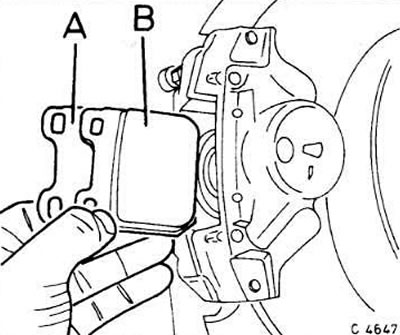
Fit the wheels, lower the vehicle and tighten the wheel bolts crosswise to 110 Nm.
Attention! Press the brake pedal hard several times until a strong resistance is felt. This leads to the correct fit of the pads.
Check the fluid level in the tank, if necessary, add fluid to the mark "MAX".
Let the new pads run in by slowing down the car several times by lightly pressing the pedal from a speed of 80 km / h to 40 km / h. Allow brakes to cool between braking.
Attention! When running the first 200 km, avoid sudden braking.

Visitor comments